Quilt-As-You-Go is so much more than just log cabins! Try this new Blooming Quilt Pattern technique for a fun effect.
I recently shared a pillow on my Instagram and I was asked a number of times how I created it. I finally got my act together and created this little how-to. I’m calling it the Blooming Quilt Pattern, as it looks a lot like a flower starting to bloom. If you have any questions, just leave them in the comments and I’ll try and help you out and/or modify the tutorial so it makes more sense.
I learned the basic scrappy quilt-as-you-go via a great tutorial over at Oh, Fransson! Her version is lovely and straight, like a log cabin block. It was the perfect introduction to QAYG, and I’d highly recommend giving something small like this a shot to get comfortable with it.
I’ve taken the same process and made it wonky. The technique is the same, but it sort of requires a bit of mental geometry — the ability to see where you’re headed before you get there.
I’m participating in the Pretty Little Pouch Swap, so I thought I’d create the front panel of the pouch using this method, and write up this tutorial as I went! I hope my partner loves the pouch I’m creating.
Blooming Quilt Pattern Supplies
- Backing fabric
- Batting
- Scrap fabric
- Iron
- Cutting mat
- Fabric scissors
- Ironing board
- Spray basting
- High-quality thread
- Bobbin
- Sewing machine
- Walking foot
- Rotary cutter
Blooming Quilt Pattern Instructions
There will be three layers to this panel. A backing fabric, the batting, and the scrappy top. Unlike a normal quilt sandwich, the back of your panel will be not so pretty. So it’s perfect for making things with a lining — pouches, bags, pillows, etc. It doesn’t work so well for an actual quilt.
You’ll want your iron and cutting mat close by, as well as your scissors. I lower my ironing board and put it right next to my table, as well as put my small cutting mat right next to my machine. This saves me from walking over to my big cutting table after each step.
Choose your fabrics. You can do this with any fabrics, but I find that a gradation of color works particularly nicely, as well as a range of values — dark to light. For this pouch, I chose a selection of pinks, purples, and grays. Cut strips between 1″ and 2″ wide, or pull from your stash. It’s perfect for scrap-busting.
Cut a piece of batting the size of the panel you want. My panel is 8.5″ x 8.5″. Back the panel with a utility fabric. For this pouch, I used an inexpensive cotton (seriously, like $1.99 a yard) since it will be inside the lining of the pouch. I cut it a little wider than the batting, just in case it shifts. You can spray-baste them together if you’d like.
Set up your machine to quilt. Lengthen your stitch a bit, and use high-quality thread. This is a thread-intensive project, so you might want to wind an extra bobbin or two, depending on how big your panel is, or how many you’re making. Just to make this small square I used nearly an entire bobbin!
I didn’t use my walking foot — my machine quilts fine without it. But if you’re more comfortable quilting with it, go for it. Pick the fabric you’d like as the center of the “flower,” and quilt it, right-side up, straight to the batting. I like to start it a bit off-center, but you could start it anywhere on the panel.
I used simple straight-line quilting, but you could do some FMQ or use other patterns. To save thread, when I came to the end of the fabric, I turned the panel, stitched three stiches down, and then stitched back the other way across the fabric. It actually goes pretty quickly once you get the hang of it.
Here’s a quick video I made of how to do the turning: QAYG Video Tutorial. Can I figure out how to embed it? Of course not. Does it have a bit on the end where I pick up the camera to turn it off? Indeed. Are my thumbs blocking the camera half the time? You betcha. But the fact I even made a video in the first place should be cause for celebration. Hip, hip, hooray!
Moving on.
Here is what should have:
In a traditional log cabin, you’d lay the next piece perpendicular to the first piece. Instead, lay your second piece face down at an angle, so the two pieces are right-sides together. Sew along the edge of the piece with 1/8″ seam.
Open up the two pieces and press the new piece away from the first piece. Quilt that one using the same technique you used on the first piece.
Add another piece across from it using the same method. Basically, instead of making a square, you want to make more of a pentagon, with five sides instead of four. So every piece will be angled. I use each fabric (except the first fabric) two or three times as I work my way out from the center. You’ll see this more as it starts to come into form.
Continue adding pieces at an angle. You want to make sure to cover up all edges and seams with the pieces you’re adding. You’ll see below that the light purple piece (right-side down in the photo) covers the two ends of the darker pink pieces, so that when it’s opened, those ends are hidden.
You can already see the flower starting to take shape.
Keep adding pieces. It’s hard to go wrong — I’ve had whole pieces I’ve ended up covering up. Just make sure that the pieces you are adding are covering up the ends of the strips as you go — you don’t want frayed edges showing.
When I start to get to the edge, I like to trim as I add pieces. I trim after I open up a piece and iron it, but before quilting it. That means I’m not quilting anything extra.
Keep going around in a circle, adding pieces. You’ll be surprised. You’ll cut a large piece of fabric, and by the time you’ve added others on top of it, only a small triangle is showing in the end.
It’ll take some getting used to, but as you see the shape take form, where to put the next pieces will become more clear. It’s difficult to visualize at first, but after a while it should make more sense (I hope!)
Keep on adding. You’ll use more fabric strips than you’d expect.
Soon you’ll be finished! Trim down your edges and square up your block (if you’re making a square). You’re ready to use this panel when you make a bag or pillow or mug rug!
Let me know if you give this Bloomin’ Quilt-As-You-Go a shot — I’d LOVE to see what you create with it!
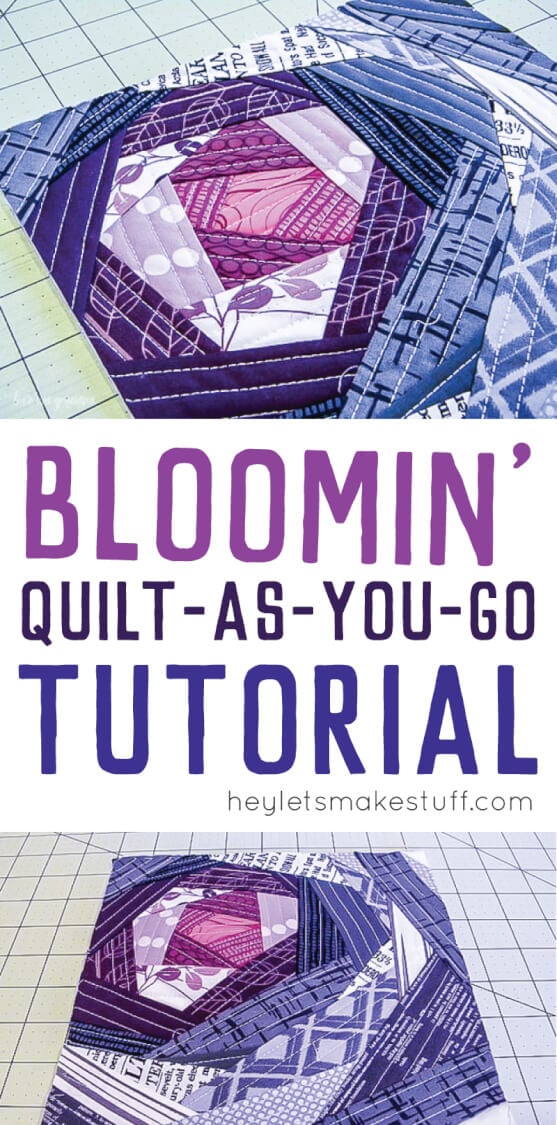
More Quilt as You Go Fun!
- Learn Quilt-As-You-Go: Easy Big Stripes Panel
- Bloomin’ Quilt-As-You-Go Tutorial
- Seaside Boardwalk Quilt-As-You-Go Tutorial
- Scattered Geese Quilt-As-You-Go Tutorial
- Go Fly a Kite Quilt-As-You-Go Tutorial
- Step It Up Quilt-As-You-Go Tutorial
- Bear Mountain Quilt-As-You-Go Tutorial
- Scottish Thistle QAYG Block
- North West Quilt-As-You-Go Block Tutorial
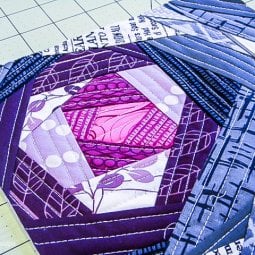
BLOOMING QUILT PATTERN
Equipment
Supplies
- Backing fabric
- Batting
- Scrap fabric
- High-quality thread
Instructions
- There will be three layers to this panel. A backing fabric, the batting, and the scrappy top. Unlike a normal quilt sandwich, the back of your panel will be not so pretty. So it's perfect for making things with a lining — pouches, bags, pillows, etc. It doesn't work so well for an actual quilt.You'll want your iron and cutting mat close by, as well as your scissors. Lower your ironing board and put it right next to your table, as well as put your small cutting mat right next to the sewing machine. This will save you time with each step.Choose your fabrics. You can do this with any fabrics. Find though that a gradation of color works particularly nicely, as well as a range of values — dark to light. For this pouch, a selection of pinks, purples, and grays were chosen. Cut strips between 1" and 2" wide, or pull from your stash. It's perfect for scrap-busting.

- Cut a piece of batting the size of the panel you want. This panel is 8.5" x 8.5". Back the panel with a utility fabric. For this pouch, an inexpensive cotton (seriously, like $1.99 a yard) was used since it will be inside the lining of the pouch. Cut it a little wider than the batting, just in case it shifts. You can spray-baste them together if you'd like.

- Set up your machine to quilt. Lengthen your stitch a bit, and use high-quality thread. This is a thread-intensive project, so you might want to wind an extra bobbin or two, depending on how big your panel is, or how many you're making. Just to make this small square I used nearly an entire bobbin!The walking foot wasn't used as this machine quilts fine without it. But if you're more comfortable quilting with it, go for it. Pick the fabric you'd like as the center of the "flower," and quilt it, right-side up, straight to the batting. Start it a bit off-center, but you could start it anywhere on the panel.

- Use a simple straight-line quilting, but you could do some FMQ or use other patterns. To save thread, when it comes to the end of the fabric, turn the panel, stitch three stiches down, and then stitch back the other way across the fabric. It actually goes pretty quickly once you get the hang of it.Here's a quick video of how to do the turning: QAYG Video Tutorial. Here is what you should have:

- In a traditional log cabin, you'd lay the next piece perpendicular to the first piece. Instead, lay your second piece face down at an angle, so the two pieces are right-sides together. Sew along the edge of the piece with 1/8" seam.

- Open up the two pieces and press the new piece away from the first piece. Quilt that one using the same technique you used on the first piece

- Add another piece across from it using the same method. Basically, instead of making a square, you want to make more of a pentagon, with five sides instead of four. So every piece will be angled. Use each fabric (except the first fabric) two or three times as you work your way out from the center. You'll see this more as it starts to come into form.

- Continue adding pieces at an angle. You want to make sure to cover up all edges and seams with the pieces you're adding. You'll see below that the light purple piece (right-side down in the photo) covers the two ends of the darker pink pieces, so that when it's opened, those ends are hidden.

- You can already see the flower starting to take shape.

- Keep adding pieces. It's hard to go wrong — Just make sure that the pieces you are adding are covering up the ends of the strips as you go — you don't want frayed edges showing.

- When you start to get to the edge, trim as you add pieces. Trim after you open up a piece and iron it, but before quilting it. That means you are not quilting anything extra.

- Keep going around in a circle, adding pieces. You'll be surprised. You'll cut a large piece of fabric, and by the time you've added others on top of it, only a small triangle is showing in the end.

- It'll take some getting used to, but as you see the shape take form, where to put the next pieces will become more clear. It's difficult to visualize at first, but after a while it should make more sense.

- Keep on adding. You'll use more fabric strips than you'd expect.

- Soon you'll be finished! Trim down your edges and square up your block (if you're making a square). You're ready to use this panel when you make a bag or pillow or mug rug!

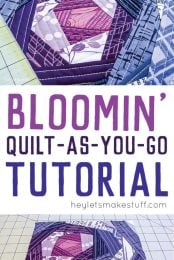
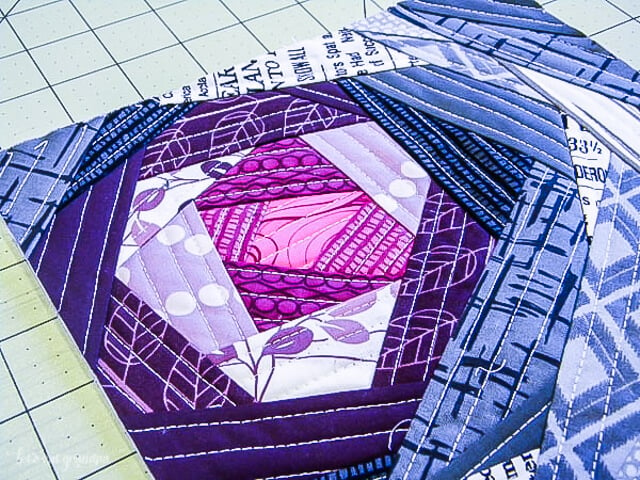
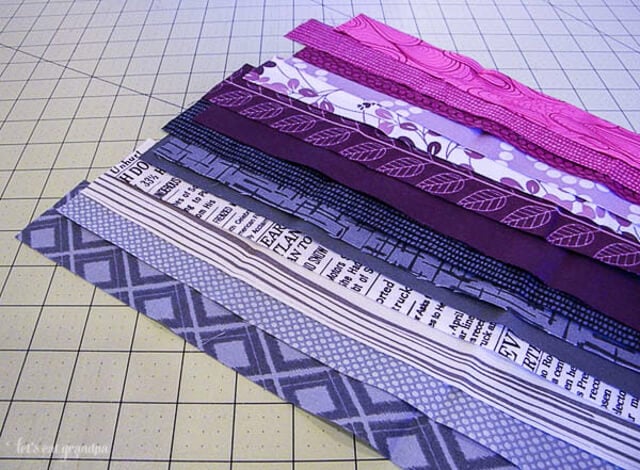
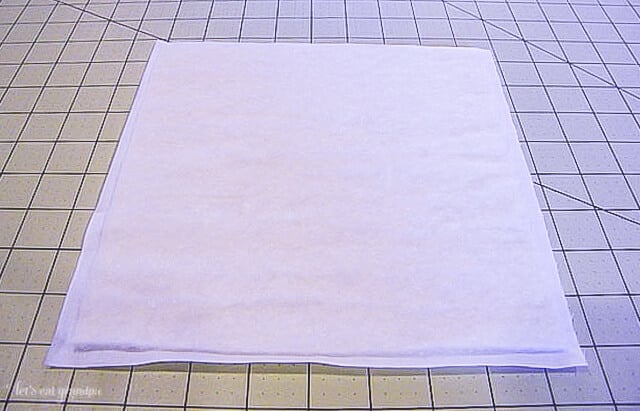

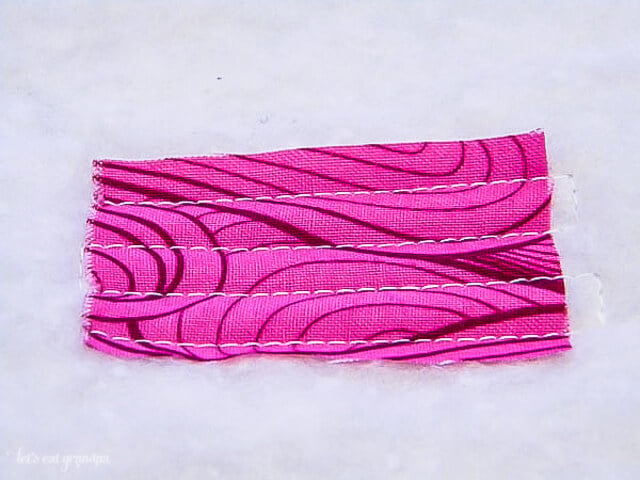
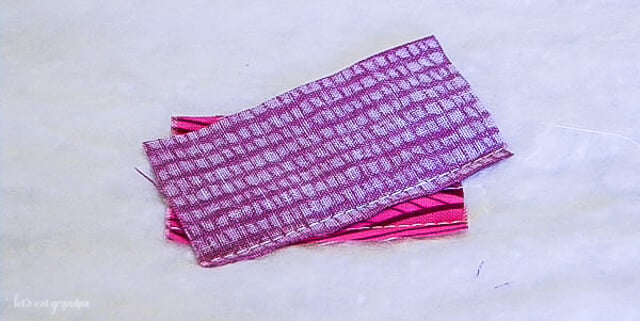
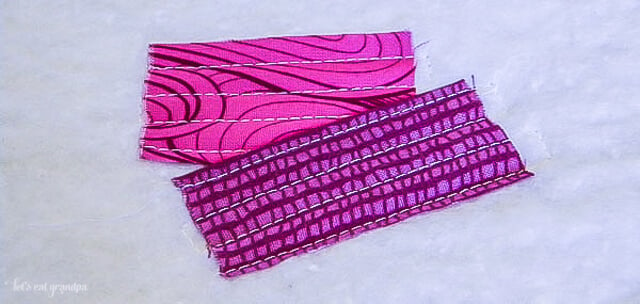

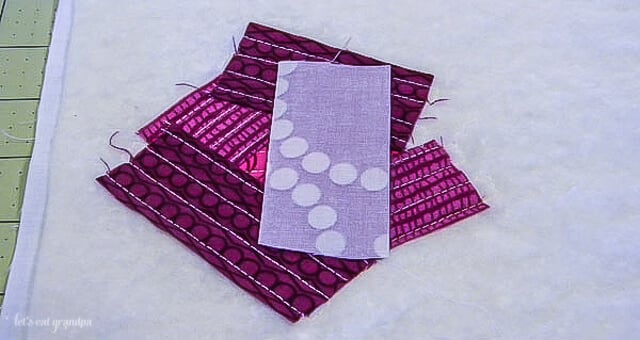
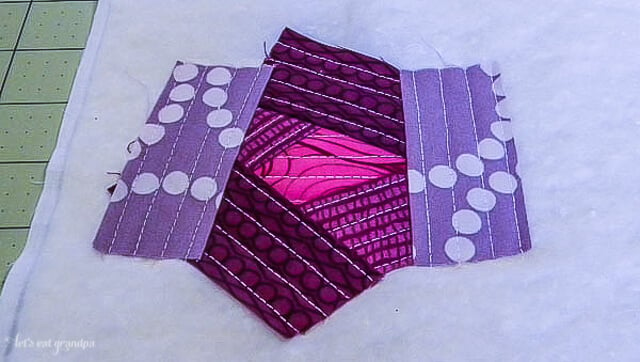
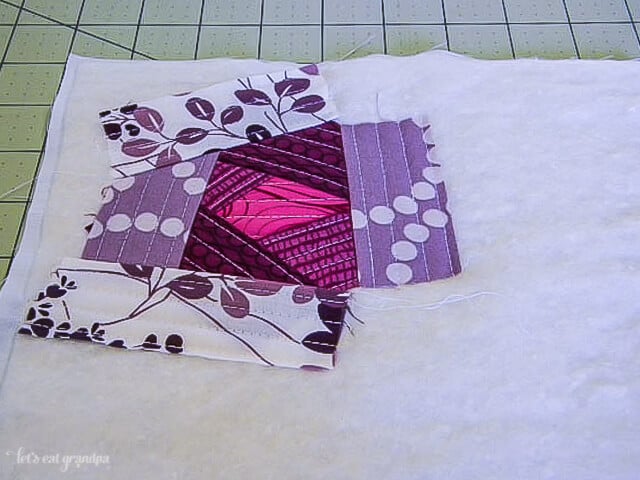
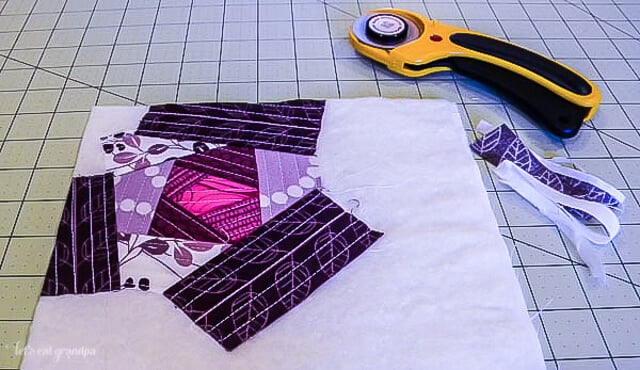
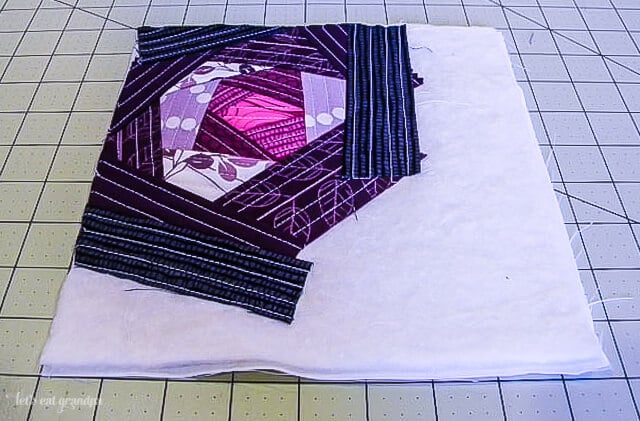
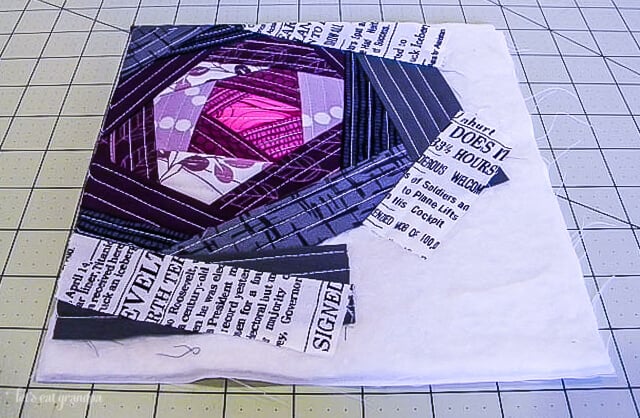
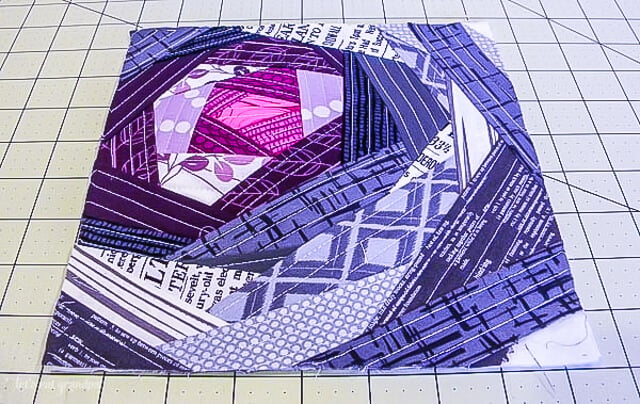
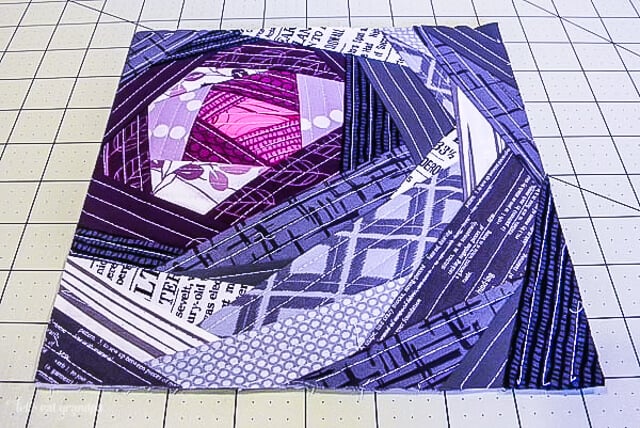
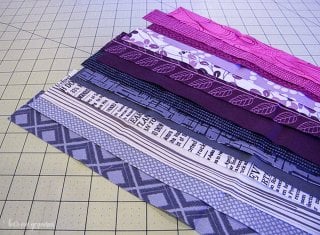


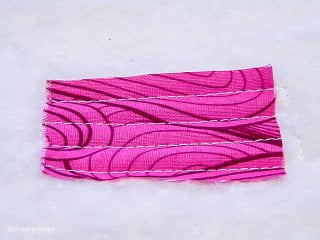
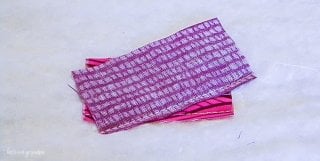
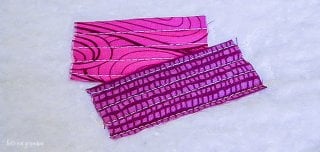
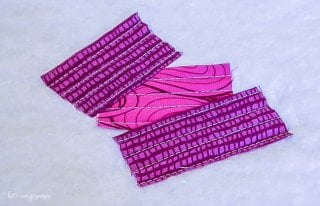

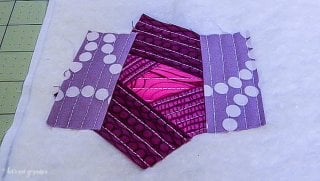
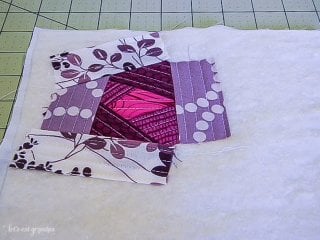
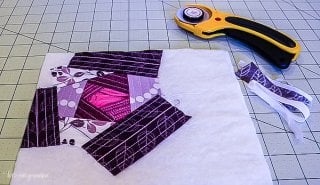
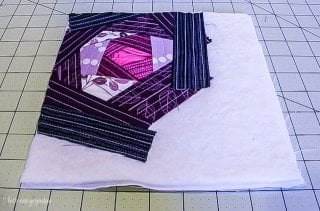
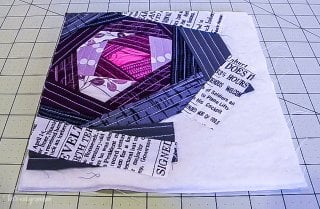
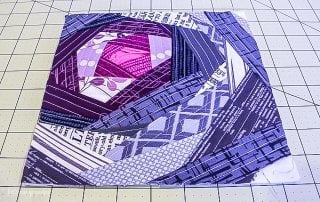
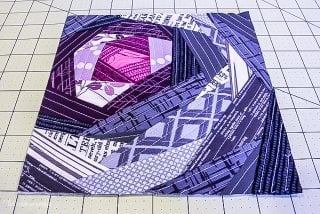


Comments & Reviews
Courtney says
I love this and purple is my favorite color too. Thank you for making a tutorial. :)
Cori George says
You’re so welcome Courtney!
valerie says
amazing. thank you for the inspiration
Rene says
So inspired! Is it possible to use this technique in making a quilt? The thickness of the seams would be an issue I would think. Your thoughts and suggestions greatly appreciated. Wonderful job, though. I may give this a try. ?
Jenna says
I loved this design so much that I took it in a bigger direction! Instead of quilting as I went, I kept adding the bloom on the quilt top until it reached about 5 feet. I can’t wait to do another one, this time quilting as I go and making different color blooms!
http://i.imgur.com/8RyH7Ss.jpg
Cori George says
THIS IS SO COOL! Thanks for sharing!!
Patricia says
Thanks! Looks like an easy yet unusual Potholder set for me!
Erika says
I loved this pattern. So gorgeous. I made a pillow following it and write on my blog, likning to your tutorial. Here’s the post: Quilt as you go » Ikochan
http://www.ikochan.se/2016/04/02/quilt-as-you-go/ .Thank you for a wonderful tutorial :)
Anela says
When I decided to take on quilting last Christmas, I ambitiously started with a baby blanket. But once I got to the quilting part, I realized I needed practice first! I used your qayg tutorial to make an accompanying pillow first. Would love to get your thoughts!
Here’s my post on it: https://byanela.wordpress.com/2016/01/31/my-first-quilted-project/
Anca says
Hi Cori!
Thanks for the tutorial, I experienced for the first time QAIG.
I’d like to send you I picture but do not know how :)
Regards,
Anca
Margaret says
this is amazing and has actually inspired me to try and make some cushion covers for my lounge. Thank you!!!!
Cori George says
Do it! I’d love to see what you come up with :)
MPaula says
I am planning to make a duvet cover (considering it has been in my mind for several years, who knows when it will get done) and wondered if quilt-as-you-go would be an appropriate method. I continue to use the cover alone when it becomes too hot for the duvet.
Considering that the back of the quilt would be hidden by the fabric used for the other side of the cover, ugliness is not a concern. The stiffness might be a problem so I will start with a smaller project first to get a feel for it (unintended pun!). Obviously I would have to make squares or rectangles to make the top and then stitch them together.
Thanks for your tutorial. I am pinning it for when I actually get started.